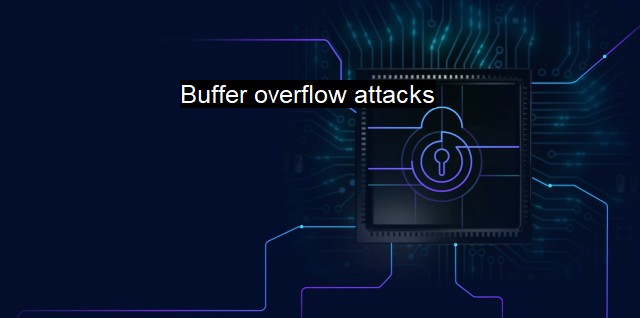What are Buffer overflow attacks?
Understanding Buffer Overflow Attacks: The Risks They Pose to Cybersecurity
Buffer overflow attacks constitute a significant security threat within the realm of cybersecurity. Characterized by their generic and troublesome nature, these offenses are aimed at exploiting a software program’s vulnerability pertaining to its management of data storage within its buffer. Intricately complicated yet undeniably powerful, buffer overflow attacks have the potential to wreak havoc within an application's structure, sometimes leading to irreversible damage.A buffer, in the context of digital computing, refers to the temporary area of storage within a computer's physical memory that holds data momentarily while it's being transferred from one location to another. Buffers operate on the principle of 'first in, first out' scheduling, within the system, they are commonly utilized to bridge the difference in speed between different hardware components of a computer system.
It's their primary function to hold data in the interim that at times, becomes an Achilles heel for them in terms of cybersecurity through buffer overflow attacks. A buffer overflow attack exploits the buffering capabilities, where an attacker intentionally sends more data to a buffer than it can handle. This surplus data then spills over into other memory areas of the system, overwriting the information stored there, leading to undesired results that vary in severity from program crashes to potential unauthorized system access for maleficent individuals.
From the perspective of a cyber attacker, buffer overflow attacks are prime weapons deployed to disrupt system integrity, privacy, and confidentiality since they allow the execution of malicious payload code through unauthorized system access. The excess data inserted into the buffer often contains specific instructions in the form of code meant to initiate such illicit tasks. This inserted precision code usually results in exploiting the system to create a shell that acts as a gateway for the attacker to gain further unauthorized entry into the system.
These buffer overflows can be classified into two main types; Stack-based and Heap-based buffer overflows. Stack based overflows target the stack - a part of memory intended to keep temporary variables - of a system application. Heap based overflows exploit the heap storage area - designed for holding the program data. The stack-based overflow attacks are more common of the two given the systematic predictability of the stack that can be exploited by notorious cyber-attackers.
Cybersecurity solutions tackle the problem of buffer overflow attacks with a variety of insightful approaches, with the primary one being incorporating safety checks within the code that ensure that excessive data doesn't disrupt the normal execution of a program. In newer programming languages, automatic bounds checking mechanisms are put in place to prevent buffer overflow.
Antivirus software, on the other hand, provides a unique layer of protection by identifying the signatures associated with buffer overflow exploits. Antivirus programs are updated regularly to include these signatures, allowing them to promptly detect if an ongoing program is attempting a buffer overflow attack.
Address Space Layout Randomization (ASLR) constitutes a valid countermeasure to buffer overflow attacks.This technique involves randomly arranging the positions of crucial areas of a process's address space which can thwart an attacker's exploitation efforts since the randomness introduced makes it significantly difficult for an attacker to predict target addresses.
Periodic security patch updates for the Operating software decrease the risk of such breaches. It's also prudent to ensure that the most trusted and latest versions of software applications are being used which are usually post several vulnerability fixes.
Despite their perilous nature, buffer overflow attacks can be effectively managed through a comprehensive integration of vigilant coding practices, cyber hygiene and robust antivirus protection mechanisms. a coherent understanding of the inherent vulnerabilities within computer systems, such as buffer overflow potential, is the first critical step towards creating a more secure digital world.

Buffer overflow attacks FAQs
What is a buffer overflow attack?
A buffer overflow attack is a type of cyber attack where an attacker sends more data to a program or process than it is designed to handle. This extra data overflows the buffer (temporary storage area), causing the program to crash or behave unexpectedly.What are the consequences of a buffer overflow attack?
The consequences of a buffer overflow attack can be severe. An attacker can exploit this vulnerability to execute malicious code on the target system, steal sensitive data, compromise user accounts, or take control of the entire system.How can I prevent buffer overflow attacks?
Buffer overflow attacks can be prevented by following secure coding practices, such as input validation, boundary checking, and error handling. Additionally, using memory-safe programming languages, such as Rust and Swift, can help prevent buffer overflow vulnerabilities. Regular software updates and patching can also help mitigate the risk of buffer overflow attacks.Can antivirus software detect buffer overflow attacks?
Antivirus software can detect some types of buffer overflow attacks by analyzing the behavior of running processes and inspecting system memory. However, antivirus software is not foolproof and may not be able to detect all types of buffer overflow attacks. Therefore, it’s important to follow secure coding practices and regularly update software to minimize the risk of buffer overflow attacks.| | A | | | B | | | C | | | D | | | E | | | F | | | G | | | H | | | I | | | J | | | K | | | L | | | M | |
| | N | | | O | | | P | | | Q | | | R | | | S | | | T | | | U | | | V | | | W | | | X | | | Y | | | Z | |
| | 1 | | | 2 | | | 3 | | | 4 | | | 7 | | | 8 | | |||||||